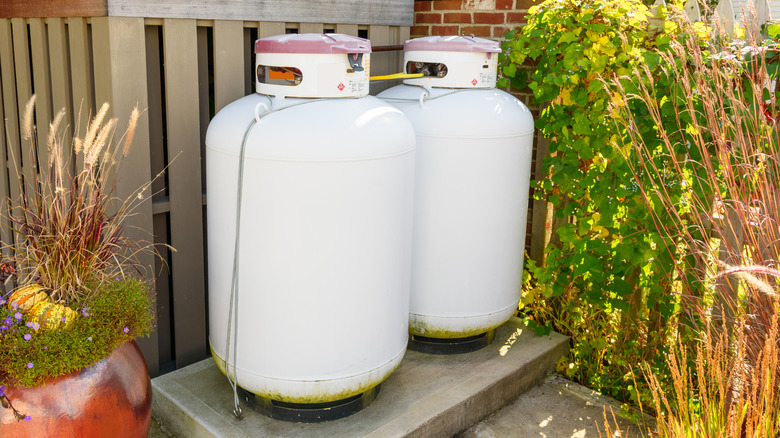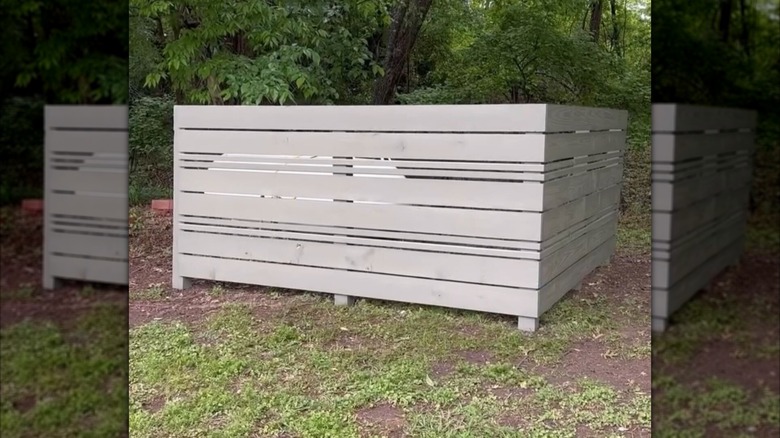Propane Heat Woes: Hide Your Unsightly Tank With A Faux Fence Hack
We fall in love with our homes in much the same way we experience a new romance. At first, we're infatuated, and every little quirk seems so charming, whether it's a slightly off-color floorboard here or a strip of wallpaper that's ever so slightly out of alignment there. And you genuinely love those tiny imperfections because your romance with your new home wouldn't be the same without them. But sometimes, a big thing comes along that you just can't see your way around — literally — because this big thing is a huge, frankly ugly propane tank that is totally throwing off the pastoral vibes in the backyard.
Thankfully, there's no need to try to work it out with this unattractive propane tank. This is one situation where it's perfectly acceptable to put a fence up around the problem and never think about it again, as long as you avoid making one of the mistakes everyone makes when installing a fence. Home DIY project creator @maggiemcgaugh on Instagram hid their propane heater using a simple design that would be easy to assemble for anyone looking to DIY a stylish fence to beautify an otherwise unsightly area of their property.
How to build your DIY fence
This project can easily be completed in under a weekend. That's because the Instagrammer installed what's called a "no-dig" fence. Traditional fences are secured into the ground via fence posts, a labor-intensive process that requires digging holes and pouring concrete. This no-dig fence rests on the ground and supports itself with its L shape. If the fence were one panel instead, it would be anchored by simple spikes.
If you're using spikes, contact your local municipality before starting to check the location of underground utilities. Your fence may also require permits or be subject to regulations, like height limits. Measure the build area to determine how many posts and boards you need.
For this L-shaped fence, @maggiemcgaugh used five posts about 5 to 6 inches wide and 4 feet tall, and laid them out 4 feet apart. Three posts arranged this way creates a length of 8 feet. If your fence has a horizontal design, you'll need boards 8 feet in length. Where each board crosses a post, use two 4-inch nails to secure the board to the post. Next, to complete the other part of the L shape, lay out the other two posts 4 feet apart and nail the boards to them, leaving the boards free floating at one end. Arrange that fence panel at a right angle to the first one, and nail them together. Place your fence about 10 feet away from the tank to ensure safe, easy access.
Adding some style to your faux fence
With the fence complete and the propane tank out of sight, you may want to beautify your fence and add some style to your yard. For their fence, the Instagrammer painted it an unobtrusive color that blended into the landscape, and they put a little work into the design of the horizontal boards, alternating two wider boards with two thinner boards. You could forego paint altogether and enjoy either a natural look or a rich wood stain.
There are plenty of other ways to spruce up your fence. One option, if you have leftover wood, would be to build planters at the base of your fence. In addition to adding stylish flowers or vines, the soil in the planters adds weight and extra support to the fence. Another option would be to add a third or even fourth fence panel for extra stability and to create a secure enclosure, complete with an optional gate.
You may also want to consider adding lights to your fence, especially if it's near a footpath or other area that could use lighting when it gets dark. Solar powered sconces are a classy touch and easy to install, or you could opt for something as simple as running string lights along the top of the fence.

